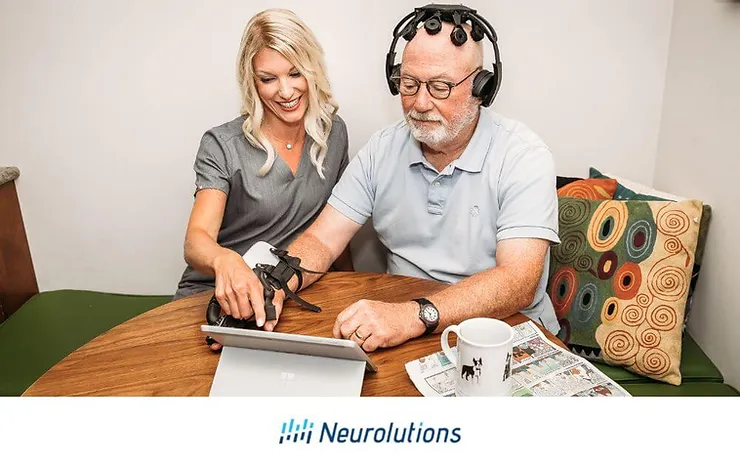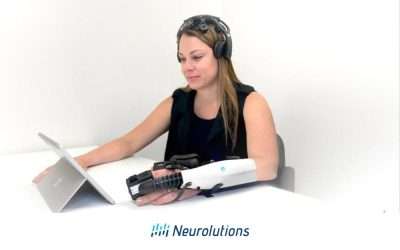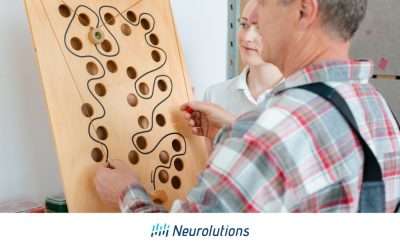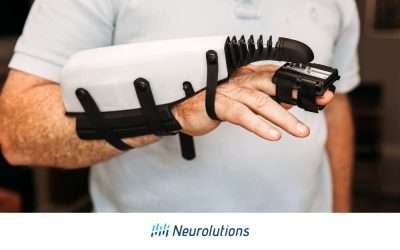Stroke Rehabilitation will be Shaped by the Development of Brain-Computer Interfaces
Capturing both human and animal “thought” and using it for a range of purposes is not just science fiction anymore.
Although brain-computer interface (BCI) has been in research and development stages for over 50 years, an era utilizing BCI in our modern world is fast approaching. Many experts agree that within the next 5-10 years, brain-computer interface technology will be all around us in both healthcare and the mass market- and is likely here to stay.
What is BCI, how will it be used in everyday life, and why should we pay close attention to it in the field of stroke rehabilitation?
What is a Brain-Computer Interface and How Does it Work?
A brain-computer interface is a cutting-edge system in which the individual uses their own brain signals to be processed by a computer for control of the output. In other words, BCI allows for direct communication between the brain and a machine for an intended purpose.
BCI systems generally consist of three main parts that each have a job to perform:
1. A sensor collects signals brain signals (like a stethoscope)
2: A computer processes the information from the brain
3: An external device, or output, receives information from the computer and produces the intended response
BCI systems are often categorized by the method used to detect and measure signals produced by the brain. BCI systems can be invasive, semi Invasive, and non-invasive.
Non-invasive BCI systems
Non-invasive BCI systems (i.e. no surgery required) by far hold the largest share of the growing market and are probably most feasible to use in the majority of the population. These systems usually have strategically placed electrodes inside of a headset in order to read the brain’s signals and are accomplished through EEG (electroencephalography) recording.
Semi-invasive and Invasive BCI Systems
Semi-invasive and invasive BCI systems both require surgery and hold higher risks. However, these systems are being explored in neurorehabilitation to restore function in individuals who have chronic or terminal health conditions, such as those with paralysis from a spinal cord injury or those with ALS.
The marvel and intrigue of a brain-computer interface are that it builds a bridge between the human brain and the outside world.
With many new technologies, there are certainly many unknowns and that lies behind the power of this emerging field of science and research as it integrates into our everyday lives. Presuming appropriate policy regulations and ethical constructs are put into place, there are many opportunities for BCI in our world if risks are mitigated and carefully managed.
Imagine a future utilizing thought and/or brain signals powered by BCI for:
- Alternative communication channels (e.g. speaking, typing, software navigation) for users with mobility, cognitive, or speech impairments
- Control of various transportation modes, such as a wheelchair/scooter or even a vehicle for those who cannot utilize traditional control methods
- Controlling home appliances and devices in a way that is more accessible
- Operating a personal smartphone or smart device in a way that is more accessible
- Increase productivity or alter brain state for function (i.e. sports, performance) by selecting specific music/beats to influence brain waves
- Help those with stroke, quadriplegia, or degenerative disease regain limited control over their bodies
Aiding Stroke Challenges with Brain-Computer Interface
Despite advancements in modern healthcare, stroke is still a leading cause of long-term disability in our country and also our world (1). Following the weeks and months after the acute phase of a stroke ends, a significant portion of chronic stroke survivors must live with their deficits for an extended period of time.
A few statistics on stroke survivors:
- 15-30% experience long-term functional limitations (2)
- ~20% require institutional care (2)
Learn more about strokes and stroke statistics in our other blog articles.
The aftermath of a stroke can be devastating and often alters an individual’s prior level of function and the lifestyle they led before the stroke. Stroke also affects those around the survivor too, placing a burden and concern on loved ones.
The classic dogma has been that those in the chronic phase of stroke have plateaued.
Stroke survivors and their families have commonly been told that their recovery has ended. They are encouraged to optimize what the stroke survivor has left, rely on adaptive equipment and devices, and “live with what they’ve got.”
The Benefits of Brain-Computer Interface for Stroke Rehabilitation
Neuro-rehabilitation sciences are in need of techniques and practical interventions which prolong or even reopen a period of increased brain plasticity so recovery can be optimized.
Brain-computer interface for stroke rehabilitation may be one solution to the vexing problem.
The success of the development of BCI systems to assist the motor functional recovery in the hemiplegic or hemiparetic limb in stroke survivors will be significant because they will provide systems for improving quality of life and functional ability in chronic stroke survivors who would otherwise have permanent loss of function. (4)
It is undeniable that there is room to grow the development and also implementation of interventions useful for stroke rehabilitation in the acute phase, subacute phase, and well into the chronic phase.
What are the Benefits of BCI Treatment for Strokes?
Brain-Computer Interface Provides Therapeutic Opportunities for Those With Significant Weakness:
One of the main benefits is that no active movement is required to use certain BCI devices that are preparing to enter the market. This is important because many individuals with moderate and severe weakness/paralysis after stroke cannot engage in many other types of conventional therapy as their mobility is too limited. The aim of BCI is to create new pathways in the brain so the individual gains enough motor skills back to participate in more advanced tasks and activities that would benefit their stroke recovery.
Brain-Computer Interface Utility to Use at Home or in a Rehab Center:
Another appealing benefit of noninvasive BCI for stroke rehabilitation is its utility to use in different environments. Certain BCI stroke therapy devices preparing for the market can be used in the comfort of the home without the requirement of a health professional present. Should an individual wish to use it in the clinic or facility with their therapy provider, this will be an option in the near future for rehabilitation centers that adopt the technology as a component of their stroke rehabilitation programs.
Brain-Computer Interface User Empowerment:
BCI users provide feedback that they feel empowered because they assume a sense of control over their own bodies. Many survivors need assistance to move their limbs through their range of motion; hence, the therapy is passive and is not regarded as an approach that changes the brain. Because it is a user’s own thoughts that send the signal to operate the device and not from a passive source coming in, the aim is to intrinsically strengthen the rehearsal of connecting signals to accelerate recovery.
What Evidence Is There for Brain-Computer Interface in Stroke Recovery?
A body of evidence is steadily growing in the field of BCI as it applies to stroke rehabilitation. Overall, the literature indicates that noninvasive BCI using EEG analytics is a promising general approach for motor rehabilitation post-stroke (see article references).
There are many people who are able to think about moving but cannot actually move because of damage to brain-controlled motor pathways. Leveraging novel brain-powered BCI devices, there is hope that the rehearsal of specific thoughts to produce movement will positively impact neuroplasticity and neural circuitry in an effort to rehabilitate after stroke.
Although there is far more to learn about the brain’s physiological response to various dosages of BCI as well as functional gains between different clinical presentations using different BCI systems, conclusions from clinical trials investigating BCI and stroke have the potential for inclusion of BCI in the best practices for stroke rehabilitation.
The Future of Rehabilitation with Brain-Computer Interfaces
The use of BCI solutions is an exciting option for rehabilitation and is upon us now. We are only at the tip of the iceberg. Both research institutions, leading rehabilitation hospitals, and even private facilities have a pulse on BCI products as they gain regulatory clearance and prepare for market entry.
While we still have a great deal to learn about brain-computer interface and its applications and sustainability to a real-world user’s experience, there is tremendous potential for the use of brain-computer interface devices to integrate into best practice in rehabilitation, healthcare, and beyond.
How to Know if BCI Treatment is Right for You
Brain-computer interface is currently being researched and conducted in human clinical trials around the world for purposes of neurological and stroke rehabilitation.
Whether you are a healthcare professional and are interested in a new way to help your patients or if you or a loved one are in the process of undergoing stroke rehabilitation, seek information from BCI literature, news and press releases, the neurorehabilitation community, and stroke rehabilitation influencers/ thought leaders.
Most importantly, ask your physician if they have heard of BCI for stroke therapy and if it might be the right type of post-stroke intervention for you or a loved one.
______________________________________________________________________
Exciting update: Neurolutions has the first FDA-cleared device cleared in the United States to provide BCI therapy to individuals undergoing stroke rehabilitation. It is available to select facilities in the United States in 2022 and is preparing to be commercially available in 2023. For more information, visit www.neurolutions.com.
References
1. Lloyd-Jones, D., et al., Heart Disease and Stroke Statistics – 2009 Update: A report from the American Heart Association Statistics Committee and Stroke Statistics Subcommittee. Circulation, 2009, 119(3): p. 480-486. AHA and ASA Update
2. The atlas of heart disease and stroke. J. Mackay and G. Mensah; with S. Mendis and K. Greenland. World Health Organization (2004); and Lloyd-Jones D, et al., Heart Disease and Stroke Statistics – 2009 Update: A Report from the American Heart Association Statistics Committee and Stroke Statistics Subcommittee. Circulation, 2009; 119(3):p. 480-486.
3 Lloyd-Jones D, et al., supra note 2.
Monge-Pereira E, Ibañez-Pereda J, Alguacil-Diego IM, Serrano JI, Spottorno-Rubio MP, Molina-Rueda F. Use of Electroencephalography Brain-Computer Interface Systems as a Rehabilitative Approach for Upper Limb Function After a Stroke: A Systematic Review. PM R. 2017 Sep;9(9):918-932. doi: 10.1016/j.pmrj.2017.04.016. Epub 2017 May 13. PMID: 28512066.
5. Robotic devices and brain‐machine interfaces for hand rehabilitation post‐stroke
McConnell AC, Moioli RC, Brasil FL, Vallejo M, Corne DW, Vargas PA, et al. Robotic devices and brain‐machine interfaces for hand rehabilitation post‐stroke. J Rehabil Med. 2017;49:449–60.
Young Brittany M., Nigogosyan Zack, Walton Léo M., Song Jie, Nair Veena A., Grogan Scott W., Tyler Mitchell E., Edwards Dorothy F., Caldera Kristin, Sattin Justin A., Williams Justin C., Prabhakaran Vivek. Changes in functional brain organization and behavioral correlations after rehabilitative therapy using a brain-computer interface. Frontiers in Neuroengineering. 2014;7: 10.3389/fneng.2014.00026.
7. Brain-computer interfaces for post-stroke motor rehabilitation: a meta-analysis
Cervera MA, Soekadar SR, Ushiba J, Millán JDR, Liu M, Birbaumer N, Garipelli G. Brain-computer interfaces for post-stroke motor rehabilitation: a meta-analysis. Ann Clin Transl Neurol. 2018 Mar 25;5(5):651-663. doi: 10.1002/acn3.544. PMID: 29761128; PMCID: PMC5945970.
Sebastián-Romagosa, M., Cho, W., Ortner, R., Murovec, N., Von Oertzen, T., Kamada, K., Allison, B. Z., & Guger, C. (2020). Brain Computer Interface Treatment for Motor Rehabilitation of Upper Extremity of Stroke Patients-A Feasibility Study. Frontiers in neuroscience, 14, 591435. https://doi.org/10.3389/fnins.2020.591435




